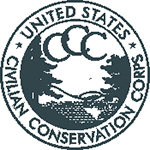History of Pymatuning State Park
Beneath the Pymatuning Reservoir lie the remains of the Great Pymatuning Swamp. The swamp is a result of the glaciers that moved and melted in this area during the last ice advance as glacial lakes filled in with sediments and became swamps.
The Shenango River flows through this ancient swamp supplying water for the Pymatuning Reservoir. The region’s glacial history can be seen in its long rounded ridges, broad upland areas, and linear valleys that are often filled with natural lakes and wetlands.
Black Jack Swamp Natural Area is a remnant of what was once the great Pymatuning swamp.
Early Inhabitants
Early inhabitants of the area included the Adena Culture, better known as the Mound Builders, from 3,000 to 1,000 years ago. The Adena were known for building burial mounds and earthwork structures. It is not known what happened to these mysterious people. Beginning in 1,050 AD, the Woodland Indians of the Monongahela Culture lived in small villages in this area. They grew corn, beans, squash, and relied on hunting and gathering of wild foods. Most of these people had dispersed by the 1630s, before the first Europeans started to arrive.
During the 1700s, there were several Delaware Indian (Lenni Lenape) settlements along the western border of Pennsylvania. The settlement known as Pymatuning Town was located south of the present day reservoir along the bank of the upper Shenango River, known at the time as Pymatuning Creek, near the mouth of Crooked Creek and is first shown on maps as Pymatuning in 1761. The name Pymatuning translates to “crooked mouth man’s dwelling place.” The settlement was abandoned in 1778 when the Delaware moved to the interior of present day Ohio.
Pioneer Settlement
The vast and formidable swamp discouraged overland travel and settlement. Two important events changed that. First was the Land Act by passage of the Pennsylvania legislature in 1792. The act opened all unsettled lands in northwestern Pennsylvania for sale to pay off its debt from the Revolutionary War. The second event was the signing of the 1795 treaty at Fallen Timbers between General Anthony Wayne and the Iroquois Nation. After these events, settlers began to arrive in the area.
Several land companies purchased the land and provided surveyors, roads, and bridges. Most of the land in the Pymatuning area was purchased by the Pennsylvania Population Company, who sold the land as 100-acre and 200-acre tracts. As a condition of purchase, the settlers were required to erect a cabin within one year and clear at least ten acres within two years. Establishing a homestead was difficult due to swampy areas, poor soils, and on-going land disputes, making settlement slow.
Pymatuning Reservoir
“All human accomplishments begin with a dream.” The Honorable Gifford Pinchot, then governor of Pennsylvania, delivered these stirring words as part of his address at the Pymatuning reservoir ground breaking in 1931. Pinchot was fulfilling a Pennsylvania dream that began in 1868 when the General Assembly provided a survey and an estimate of the cost to drain the Pymatuning swamp to create farmlands. However, the swamp was not drained because it would cripple the industries downstream in the Beaver and Shenango Valleys.
A severe flood in 1913 spurred the legislature to action. The Pymatuning Act, signed the same year, appropriated $100,000 to initiate building a dam. The Pymatuning Act states that the primary purpose of the Pymatuning Reservoir shall be for the conservation of waters entering the Pymatuning Swamp and for regulating the flow of water in the Shenango and Beaver Rivers. A secondary purpose is to use the dam and lake as a reservoir to impound flood water during periods of excessive runoff from the 158 square miles of drainage area above the dam. Construction of the concrete “spillway bowl” allowed independent regulation of the 2,500-acre upper reservoir to provide optimal wildlife habitat.
It took 18 years for public and private organizations to raise the funds needed to build the dam. Work began in the fall of 1931. It took three years and almost 7,000 men to turn the dream into a reality.
Civilian Conservation Corps

During 1935, the Civilian Conservation Corps (CCC) built Camp NP-11-PA at Pymatuning. The young men of the camp built buildings, roads, fought fires, and performed many other jobs.
Gate House
The picturesque Gate House is a castle-like stone structure which allows water flow through the dam. Water enters the gatehouse through a 20-foot-wide diversion channel and travels 280 feet to the outflow conduits. This historical structure was guarded during World War II. Today, it is the site of weddings during the summer months.
GPS DD: 41.49777, -80.46266
Pymatuning Dam
Constructed at a point where the hills converged to form a narrow valley, the earthen dam extends 2,400 feet across the valley with a maximum height of 50 feet where it crosses the old Shenango River channel. The core of the dam is made of fine-grained clay, with a row of interlocking steel pilings in the center. The pilings were driven 12 to 53 feet into the bedrock.
Heavy sandstone, ranging from 18 to 36 inches thick and hauled in by train, protects the dam from pounding waves.